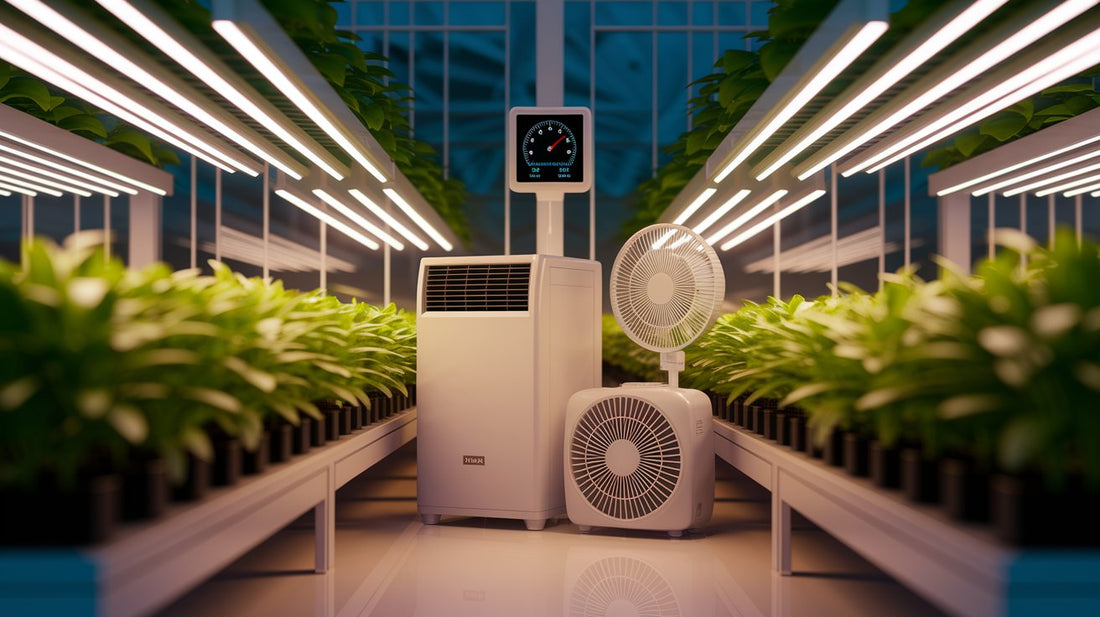
🌧️ Humidity in Indoor Growing: How to Avoid It and Save Your Harvest! 🌿
Share
Table of Contents:
- Understanding the Impact of Humidity on Plants
- The Influence of Location on Humidity
-
Essential Equipment to Regulate Humidity
3.1 The Hygrometer: The Basic Tool
3.2 The Dehumidifier: Against Excess Humidity
3.3 The Humidifier: For Too Dry Spaces
3.4 Fans: To Avoid Stagnant Areas
3.5 The Air Extractor: A Must-Have - Pots: A Crucial Choice Against Mold
- Prevention: Protect Your Crop Against Fungi
- Conclusion: Good Humidity Management, a Guaranteed Success!
Indoor cultivation allows control over many parameters, but humidity remains a major challenge. If it is too high, it promotes mold, root rot, and the development of pathogenic fungi. If it is too low, it slows plant growth and can cause water stress.
💡 Many growers underestimate the impact of humidity and do not take the time to analyze their environment before starting. Yet, poor humidity management can ruin a crop in the middle of the cycle, and then... hello financial losses! 😵
In this article, we will explore ALL angles of the problem and give you concrete solutions to keep a healthy and productive grow. 🚀
🔍 Understanding the Impact of Humidity on Plants
The ideal relative humidity for indoor growing varies according to growth stages:
✔ Vegetative growth : 50-70 %
✔ Flowering : 40-50 % (to avoid flower mold)
✔ End of flowering : 35-45 %
If these values are not respected, you risk having:
🚨 Too slow development (if humidity is too low).
🚨 Fungi and mold (if humidity is too high).
🚨 Poor nutrient absorption due to water stress.
In short, a poorly controlled climate can make you lose several weeks of work! 😫
🏠 The Influence of Location on Humidity
Before even setting up your grow tent, ask yourself this question: in what type of room will you be growing?
🔹 The cellar : Very humid, with stagnant air promoting mold. A powerful dehumidifier is essential.
🔹 The garage : Humidity can vary greatly depending on the seasons. Insulation and humidity control are necessary.
🔹 The attic : Often very dry in summer and very humid in winter. A humidifier or a dehumidifier may be necessary depending on the season.
🔹 The laundry room : To avoid, as it is generally too humid because of the washing machines.
🔹 A bedroom or an office: The environment is more stable there, but good ventilation is necessary to avoid moisture buildup.
👉 Before setting up your grow space, take the time to measure ambient humidity with a hygrometer! 📊
🛠️ Essential Equipment to Regulate Humidity
🎯 To keep a crop under control, here are the essential equipments:
1️⃣ The Hygrometer: The Basic Tool
First of all, invest in a digital hygrometer to monitor humidity in real time. A model with data history and alert is even better to avoid unpleasant surprises.
2️⃣ The Dehumidifier: Against Excess Humidity
If you grow in a basement or garage, a good dehumidifier is essential. It will stabilize humidity below 60% and prevent mold.
✔ Small space (less than 5m²): A compact dehumidifier is sufficient.
✔ Large space (more than 5m²): Opt for a more powerful model with automatic drainage.
3️⃣ The Humidifier: For Too Dry Spaces
If the air is too dry (less than 40% humidity), especially in winter, a humidifier is necessary. Prefer a model with automatic adjustment to avoid oversaturating the air.
4️⃣ Fans: To Avoid Stagnation Zones
Even with good humidity control, without air circulation, fungi can develop. Install an oscillating fan to homogenize the air in your grow tent.
5️⃣ The Air Extractor: A Must-Have
A good air extractor with a carbon filter allows air renewal and prevents excess moisture. Without it, stale air stagnates and promotes the proliferation of fungi.
🏺 Pots: A Crucial Choice Against Mold
As seen earlier, plastic pots promote moisture accumulation. A poorly thought-out choice can ruin your crop in the middle of the cycle.
✅ Geotextile and Air-Pot pots are a much better option!
✔ They promote root aeration.
✔ They allow more efficient water drainage.
✔ They reduce the risks of mold and rot.
Avoid skimping on pots! When you add up expenses for electricity, water, equipment, and genetics, losing a crop for a few euros saved really hurts the wallet. 😅
🛡️ Prevention: Protect Your Crop Against Fungi
Even with good humidity management, it is important to use preventive treatments to avoid fungal infections.
✔ Botryprot: Protects your plants against Botrytis (gray mold).
✔ Oidioprot: Prevents the appearance of powdery mildew on leaves.
✔ Mildiuprot: Fights downy mildew, a fungus that can destroy a plant in a few days.
These products are to be applied as preventive sprays to avoid having to deal with an infection once it has set in.
🎯 Conclusion: Good Humidity Management, a Guaranteed Success!
Growing indoors requires special attention to humidity. Not managing it properly can lead to big financial losses and huge energy waste.
🔹 Before starting, analyze your growing climate!
🔹 Use appropriate equipment: extractors, fans, hygrometers, etc.
🔹 Choose suitable pots to avoid water stagnation.
🔹 Use preventive treatments against fungi.
💡 A good grower leaves nothing to chance! And when you see the electricity and investment bills, it's better not to mess up. 😆
👉 Have you ever had humidity problems in indoor growing? Share your experiences and tips in the comments! 💬